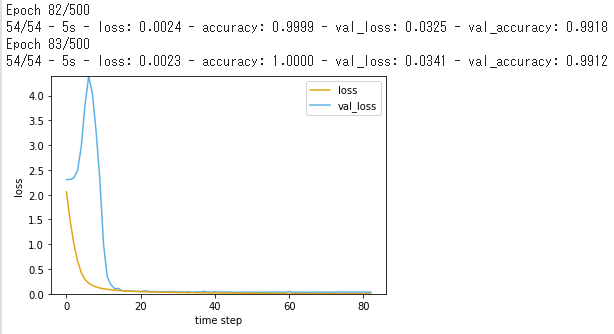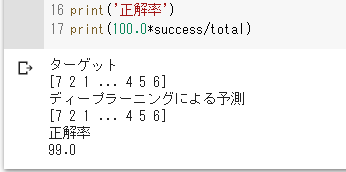はじめに
「tf.kerasでFReLUを実装」の記事を書かれている方がいらっしゃったので、それを使ってみようと思います。
https://qiita.com/rabbitcaptain/items/26304b5a5e401db5bae2
MNISTの判定をやってみる
FReLU()とそれから呼ばれるmax_unit()は上記の記事のをそのまま使います。(もし試す場合は最初に実行してください)
Functionalモデルで実装されてるようなので、Functionalモデルで作成します。
from tensorflow.keras.layers import Input, Activation
from tensorflow.keras.models import Model
from tensorflow.keras.layers import Conv2D, MaxPooling2D, GlobalAveragePooling2D
from tensorflow.keras.layers import Dense, Dropout, BatchNormalization
from tensorflow.keras.optimizers import Adam
def createModel():
main_input = Input(shape=(28,28,1,), name='main_input')
x = Conv2D(32, kernel_size=(3, 3), padding='same')(main_input)
x = FReLU(x)
x = Conv2D(32, kernel_size=(3, 3), padding='same')(x)
x = FReLU(x)
x = MaxPooling2D()(x)
x = Conv2D(32, kernel_size=(3, 3), padding='same')(x)
x = FReLU(x)
x = Conv2D(32, kernel_size=(3, 3), padding='same')(x)
x = FReLU(x)
x = MaxPooling2D()(x)
x = Conv2D(32, kernel_size=(3, 3), padding='same')(x)
x = FReLU(x)
x = Conv2D(32, kernel_size=(3, 3), padding='same')(x)
x = FReLU(x)
x = GlobalAveragePooling2D()(x)
x = Dense(units=10, activation='softmax')(x)
return Model(inputs=[main_input], outputs=[x])
MNISTのデータをロードして加工します。
import tensorflow.keras as keras
mnist = keras.datasets.mnist
(train_images, train_labels), (test_images, test_labels) = mnist.load_data()
import numpy as np
train_images_norm = (train_images / 255.0).astype(np.float16)
test_images_norm = (test_images / 255.0).astype(np.float16)
train_images_norm_rs = train_images_norm.reshape(-1, 28, 28, 1)
test_images_norm_rs = test_images_norm.reshape(-1, 28, 28, 1)
train_labels_ct = keras.utils.to_categorical(train_labels, 10)
test_labels_ct = keras.utils.to_categorical(test_labels, 10)
今回も「Raspberry Piではじめる機械学習 基礎からディープラーニングまで」に載っていた学習結果の表示用関数を使います。
import matplotlib.pyplot as plt
def plotHistory(history):
# 損失関数のグラフの軸ラベルを設定
plt.xlabel('time step')
plt.ylabel('loss')
# グラフ縦軸の範囲を0以上と定める
plt.ylim(0, max(np.r_[history.history['val_loss'], history.history['loss']]))
# 損失関数の時間変化を描画
val_loss, = plt.plot(history.history['val_loss'], c='#56B4E9')
loss, = plt.plot(history.history['loss'], c='#E69F00')
# グラフの凡例(はんれい)を追加
plt.legend([loss, val_loss], ['loss', 'val_loss'])
# 描画したグラフを表示
plt.show()
モデルの作成及びコンパイル後、学習を実行します。
from tensorflow.keras.callbacks import EarlyStopping
model = createModel()
# モデルのコンパイル
model.compile(loss='categorical_crossentropy', optimizer=Adam(lr=0.0001), metrics=['accuracy'])
model.summary()
# モデルの学習
early_stopping = EarlyStopping(monitor='val_loss', mode='min', patience=30)
plotHistory(
model.fit(
train_images_norm_rs
,train_labels_ct
,epochs=500
,validation_split=0.1
,batch_size=1000
,verbose=2
,callbacks=[early_stopping]
)
)
判定を行ってみます。
result_pred = model.predict(test_images_norm_rs, verbose=0)
result = np.argmax(result_pred, axis=1)
print('ターゲット')
print(test_labels)
print('ディープラーニングによる予測')
print(result)
# データ数をtotalに格納
total = len(test_images_norm_rs)
# ターゲット(正解)と予測が一致した数をsuccessに格納
success = sum(result==test_labels)
# 正解率をパーセント表示
print('正解率')
print(100.0*success/total)
結果
適当に作ったモデルでしたが、99%の正解率となりました。

